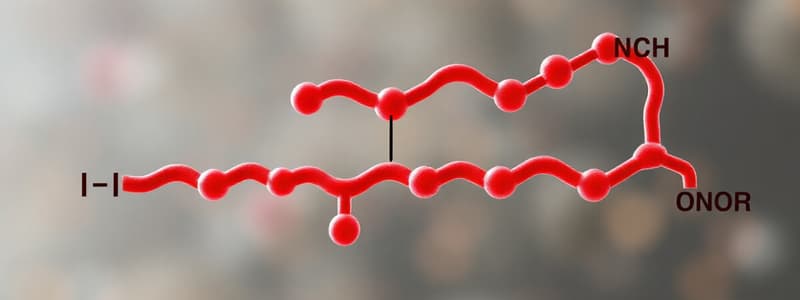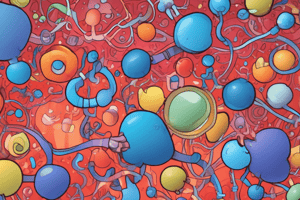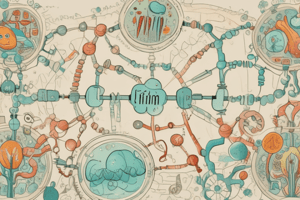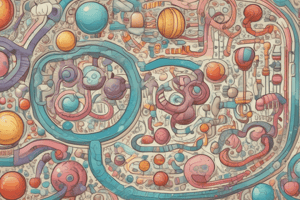Podcast
Questions and Answers
Which of the following is NOT a component of every amino acid?
Which of the following is NOT a component of every amino acid?
- Carboxylic acid group
- Phosphate group (correct)
- Unique side chain
- Nitrogen-containing amine group
An essential amino acid is best described as one that:
An essential amino acid is best described as one that:
- Must be obtained from the diet. (correct)
- Is only needed during periods of growth.
- Is less important for overall health compared to non-essential amino acids.
- Can be synthesized in sufficient quantities by the body.
What molecule is formed in the liver to detoxify ammonia, a byproduct of amino acid metabolism?
What molecule is formed in the liver to detoxify ammonia, a byproduct of amino acid metabolism?
- Lactate
- Urea (correct)
- Glucose
- Pyruvate
What enzyme catalyzes the conversion of alanine to pyruvate and glutamate?
What enzyme catalyzes the conversion of alanine to pyruvate and glutamate?
Which metabolic pathway can pyruvate enter after being converted from alanine?
Which metabolic pathway can pyruvate enter after being converted from alanine?
What is the destination of glutamate after it is produced in the metabolism of alanine?
What is the destination of glutamate after it is produced in the metabolism of alanine?
Which of the following describes glucogenic amino acids?
Which of the following describes glucogenic amino acids?
Ketogenic amino acids are primarily used to produce:
Ketogenic amino acids are primarily used to produce:
How do amino acids contribute to the citric acid cycle?
How do amino acids contribute to the citric acid cycle?
If a patient has a genetic defect that impairs the urea cycle, which of the following would you expect to observe?
If a patient has a genetic defect that impairs the urea cycle, which of the following would you expect to observe?
In the context of amino acid metabolism, what is the significance of alanine transaminase (ALT) in clinical diagnostics?
In the context of amino acid metabolism, what is the significance of alanine transaminase (ALT) in clinical diagnostics?
Which of the following metabolic conversions is most directly associated with both glucogenic and ketogenic amino acids?
Which of the following metabolic conversions is most directly associated with both glucogenic and ketogenic amino acids?
Consider a scenario where an individual consumes a diet severely deficient in essential amino acids. Which of the following metabolic consequences is most likely to occur?
Consider a scenario where an individual consumes a diet severely deficient in essential amino acids. Which of the following metabolic consequences is most likely to occur?
If glutamate dehydrogenase is inhibited, which of the following would most likely accumulate?
If glutamate dehydrogenase is inhibited, which of the following would most likely accumulate?
What is the primary reason ammonia is converted to urea in mammals?
What is the primary reason ammonia is converted to urea in mammals?
Which of the following best describes the role of non-essential amino acids in human metabolism?
Which of the following best describes the role of non-essential amino acids in human metabolism?
A researcher discovers a new enzyme that converts pyruvate directly into glutamate within muscle cells. Which of the following effects would this enzyme most likely have on overall metabolism?
A researcher discovers a new enzyme that converts pyruvate directly into glutamate within muscle cells. Which of the following effects would this enzyme most likely have on overall metabolism?
Anabolic steroids are known to increase muscle mass by enhancing protein synthesis. However, prolonged use can also lead to liver damage. Based on your understanding of amino acid metabolism, which of the following blood test results would most likely correlate with severe anabolic steroid-induced liver damage?
Anabolic steroids are known to increase muscle mass by enhancing protein synthesis. However, prolonged use can also lead to liver damage. Based on your understanding of amino acid metabolism, which of the following blood test results would most likely correlate with severe anabolic steroid-induced liver damage?
Which of the following scenarios would most likely lead to an increase in the activity of the urea cycle?
Which of the following scenarios would most likely lead to an increase in the activity of the urea cycle?
A researcher is studying a newly discovered metabolic disorder characterized by a buildup of alanine in the bloodstream. Which of the following enzymatic deficiencies would most directly explain this observation?
A researcher is studying a newly discovered metabolic disorder characterized by a buildup of alanine in the bloodstream. Which of the following enzymatic deficiencies would most directly explain this observation?
Flashcards
Amino Acid Composition
Amino Acid Composition
Amino acids are composed of a nitrogen-containing amine group, a carboxylic acid, and a unique side chain.
Essential Amino Acids
Essential Amino Acids
Essential amino acids cannot be synthesized by the body and must be obtained from dietary sources.
Non-Essential Amino Acids
Non-Essential Amino Acids
Non-essential amino acids are synthesized by the body, so dietary intake is not required.
Ammonia Toxicity
Ammonia Toxicity
Signup and view all the flashcards
Alanine Metabolism
Alanine Metabolism
Signup and view all the flashcards
Pyruvate Conversion
Pyruvate Conversion
Signup and view all the flashcards
Glutamate Destination
Glutamate Destination
Signup and view all the flashcards
Glucogenic Amino Acids
Glucogenic Amino Acids
Signup and view all the flashcards
Ketogenic Amino Acids
Ketogenic Amino Acids
Signup and view all the flashcards
Amino Acids in Citric Acid Cycle
Amino Acids in Citric Acid Cycle
Signup and view all the flashcards
Study Notes
Amino Acid Overview
- Amino acids are composed of a nitrogen-containing amine group, a carboxylic acid, and a unique side chain.
- Out of the 20 amino acids, 10 are essential and must be obtained from dietary sources like meats or tofu.
- The other 10 amino acids are non-essential and can be made in the body.
- Ammonia, derived from the nitrogen-containing amine group, becomes toxic to cells if it accumulates.
- The body removes ammonia from amino acids and sends it to the liver, where it is metabolized into urea, a less toxic molecule.
Metabolism of Alanine
- Alanine is converted into pyruvate and glutamate via alanine transaminase (ALT).
- Pyruvate can be converted into acetyl-CoA by pyruvate dehydrogenase, entering the citric acid cycle.
- Alternatively, pyruvate can be converted into lactate by lactate dehydrogenase, which travels to the liver.
- Lactate converts to pyruvate via lacate dehydrogenase and enters gluconeogenesis to create glucose.
- Glutamate's amino group is removed by glutamate dehydrogenase, forming alpha-ketoglutarate.
- Free ammonia converts into urea via the urea cycle.
How Amino Acids Are Used in the Body
- Glucogenic amino acids serve as substrates to make new glucose.
- Ketogenic amino acids form ketone bodies.
- Some amino acids enter the citric acid cycle and create NADH and FADH2 to produce ATP via the electron transport chain.
- A subset of amino acids can perform all listed processes.
Studying That Suits You
Use AI to generate personalized quizzes and flashcards to suit your learning preferences.





